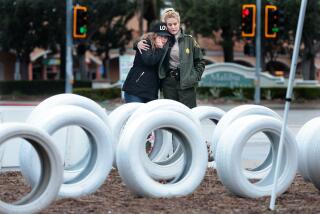Where Would We Be Without the Toll Roads?
- Share via
Re “The Toll Road Challenge,” (editorial, Dec. 9):
The Times is right about the toll roads easing congestion in Orange County. But criticizing the toll roads for not living up to growth projections is about as productive as beating a dead horse. Whether you agree with projections or not, the fact is the Transportation Corridor Agencies built $2 billion worth of new infrastructure--without any new taxes and virtually no taxpayer dollars.
Where would we be now if the toll roads had not been built? Studies paint a scary picture. Without the toll roads, congestion on key freeway chokepoints like the junction of the Riverside and Costa Mesa freeways or the El Toro “Y” would last from three to four hours longer than today.
It wasn’t a matter of building freeways or toll roads; it was toll road or no road. The only way to fund construction was to sell bonds to private investors--bonds that would be backed, not by the government but by future toll revenue so taxpayers would not be liable for repayment.
The idea was simple: Charge people to use the road and use toll revenue to repay the construction bonds. Once the bonds are paid off, the roads would turn into freeways.
Opponents claim that the “noncompetition clause” in agreements between toll-road operators and the state block much-needed freeway improvements. But TCA’s noncompetition clause, which was necessary to obtain the financing to build the roads, specifically allows billions of dollars worth of improvement projects to move forward--even if they result in lost toll revenue.
Need proof? Just drive through the reconstructed El Toro “Y” or through newly widened sections of the Costa Mesa Freeway--projects that have added lanes and improved traffic flow. In fact, the clause exempts all transportation improvements funded by the voter-approved Measure M half-cent sales tax, all projects in the county’s Master Plan of Arterial Highways and all projects envisioned in regional transportation planning documents at the time the agreements were drafted. Moreover, these agreements do not give TCA the power to block improvement projects (unlike the competition clause that binds Caltrans and the operators of the 91 Express Lanes) and allow the state to improve existing roads for operational and safety reasons.
Without the toll roads, traffic would be much, much worse. More than 220,000 cars take the toll roads every day. That’s 220,000 fewer cars that clog local freeways and roads. And, as history reminds us, the alternatives to toll roads would have been billions in additional local taxes or terminal parking-lot conditions on our freeways.
William Woollett
City manager
Aliso Viejo
The writer was chief executive officer of the Transportation Corridor Agencies from 1989 to 1999.
*
The editorial (‘Congestion’s Root Clause,” Dec. 16) lamented the 91 Express Lanes as “a failed experiment,” concluding the project is a “road-clogging” mistake. Both charges are off the mark.
The “experiment” is far more successful than The Times cares to admit, and every major study of the Riverside Freeway validates that fact. Just imagine how much worse traffic would be without our company’s investment and the four lanes we built and operate.
Equally important, the Express Lanes give the over half-million Riverside and Orange County FasTrak customers an alternative they don’t have anywhere in Los Angeles County or the Inland Empire-- time savings.
Ironically, The Times grudgingly acknowledges the stark reality California faced in the early 1990s when it whispers, “the state had big road needs, but few funds to provide them.” Yet you run right by this crucial point as if it were now irrelevant.
In reality, the 91 Freeway’s congestion can be directly attributed to those occupying the seats of power in Riverside County, as they have failed to anticipate the region’s explosive growth and all but ignored its transportation needs over the last 20 years. And they continue to do so at the peril of their constituents. Your editorial, which lays the blame at our feet instead of where it truly belongs, only serves to perpetuate the problem while giving cover to the politicians who refused to do anything to clean it up.
Greg Hulsizer
General manager, California
Private Transportation Co.
More to Read
Sign up for Essential California
The most important California stories and recommendations in your inbox every morning.
You may occasionally receive promotional content from the Los Angeles Times.










